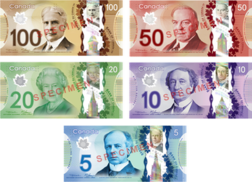| Dollar canadien (French) Can$, C$, CA$, CDN$, CAD | |
|---|---|
 2011 Frontier series (polymer notes) | |
| ISO 4217 | |
| Code | CAD (numeric: 124) |
| Subunit | 0.01 |
| Unit | |
| Unit | dollar |
| Symbol | $ |
| Nickname | Loonie, buck (in English) Huard, piastre (pronounced piasse in popular usage) (in French) |
| Denominations | |
| Subunit | |
| 1⁄100 | Cent (in English) and sou (colloquial in French) |
| Symbol | |
| Cent | ¢ |
| Banknotes | $5, $10, $20, $50, $100 |
| Coins | |
| Freq. used | 5¢, 10¢, 25¢, $1, $2 |
| Rarely used | 1¢ (discontinued, still legal tender), 50¢ (still minted) |
| Demographics | |
| Official user(s) | Canada |
| Unofficial user(s) | St. Pierre and Miquelon |
| Issuance | |
| Central bank | Bank of Canada |
| Website | www |
| Printer | Canadian Bank Note Company |
| Website | www |
| Mint | Royal Canadian Mint |
| Website | www |
| Valuation | |
| Inflation | 2.0% |
| Source | Statistics Canada, October 2024 |
| Method | Consumer price index |
| Part of a series on the |
| Economy of Canada |
|---|
 |
The Canadian dollar (symbol: $; code: CAD; French: dollar canadien) is the currency of Canada. It is abbreviated with the dollar sign $. There is no standard disambiguating form, but the abbreviations Can$, CA$ and C$ are frequently used for distinction from other dollar-denominated currencies (though C$ remains ambiguous with the Nicaraguan córdoba).[1][2][3][a] It is divided into 100 cents (¢).
Owing to the image of a common loon on its reverse, the dollar coin, and sometimes the unit of currency itself, may be referred to as the loonie by English-speaking Canadians and foreign exchange traders and analysts.[4]
Accounting for approximately 2% of all global reserves, as of January 2024[update] the Canadian dollar is the fifth-most held reserve currency in the world, behind the U.S. dollar, euro, yen, and sterling.[5] The Canadian dollar is popular with central banks because of Canada's relative economic soundness, the Canadian government's strong sovereign position, and the stability of the country's legal and political systems.[6][7][8][9][10]
- ^ "Canadian dollar (Symbol) (Linguistic recommendation from the Translation Bureau)". Translation Bureau. October 15, 2015. Archived from the original on February 19, 2020. Retrieved October 2, 2021.
In an English document, when you need to specify the type of dollar (Canadian, American, Australian, etc.), the Translation Bureau recommends using the symbol Can$ to represent the Canadian dollar. ... The shorter variant C$ is another symbol frequently used for the Canadian dollar. However, the Translation Bureau does not recommend this symbol, since it has a slight risk of ambiguity: it is also used to represent the Nicaraguan córdoba oro, Brazilian cruzeiro and occasionally the Cayman Islands dollar as well.
- ^ "World Bank Editorial Style Guide 2020 – page 135" (PDF). openknowledge.worldbank.org. Retrieved August 27, 2022.
- ^ "Currencies Facts > Major Currencies > Canadian Dollar – Canadian Dollar Currency". Oanda. Retrieved April 22, 2024.
- ^ "Report on Business: Great time for European vacation as loonie hits record high against euro". The Globe and Mail. July 12, 2012. Archived from the original on May 5, 2018. Retrieved November 9, 2014.
- ^ "Currency Composition of Official Foreign Exchange Reserves (COFER)". International Monetary Fund. 2024. Retrieved September 1, 2024.
- ^ "Canada's resilience has foreign central banks loading up on loonies". The Globe and Mail. May 13, 2014. Archived from the original on March 5, 2016. Retrieved November 9, 2014.
- ^ "What's lifting the high-flying loonie?". The Globe and Mail. September 19, 2012. Archived from the original on March 4, 2016. Retrieved November 9, 2014.
- ^ "Seven reasons to invest in Canada now". The Globe and Mail. March 11, 2013. Archived from the original on January 21, 2017. Retrieved November 9, 2014.
- ^ "China likely sitting on billions of Canadian dollars". The Globe and Mail. October 2, 2015. Archived from the original on June 15, 2018. Retrieved January 13, 2016.
- ^ "Why a world in turmoil is still parking its cash in Canada — lots of cash". The National Post. December 31, 2015. Archived from the original on May 12, 2018. Retrieved January 13, 2016.
Cite error: There are <ref group=lower-alpha> tags or {{efn}} templates on this page, but the references will not show without a {{reflist|group=lower-alpha}} template or {{notelist}} template (see the help page).